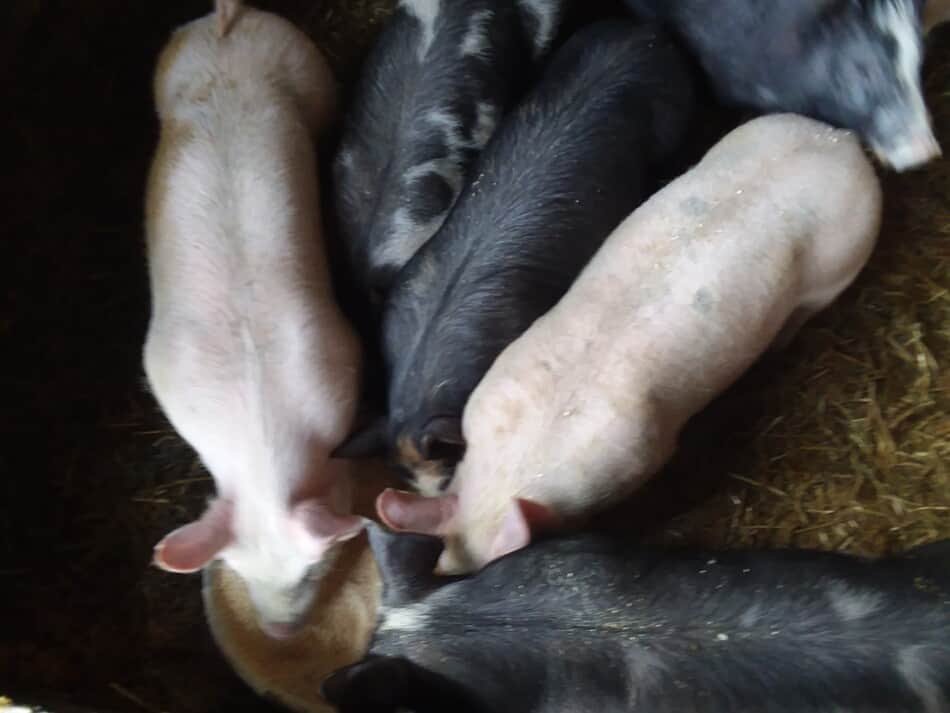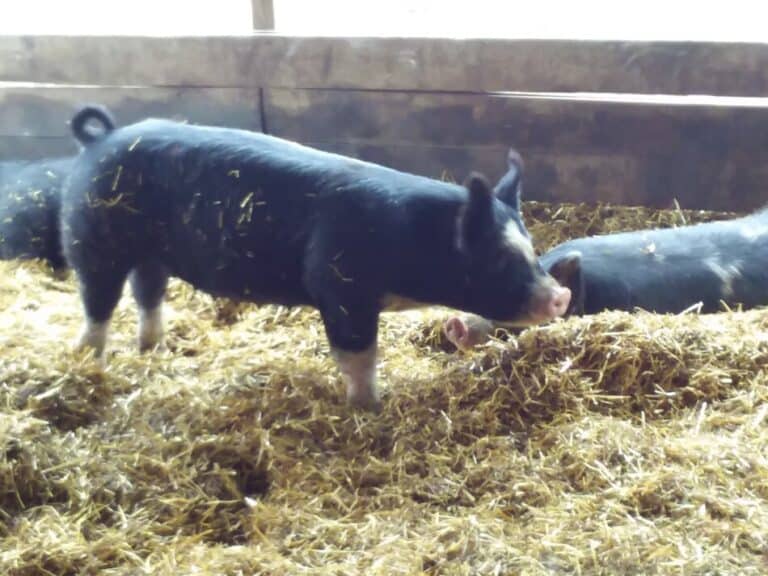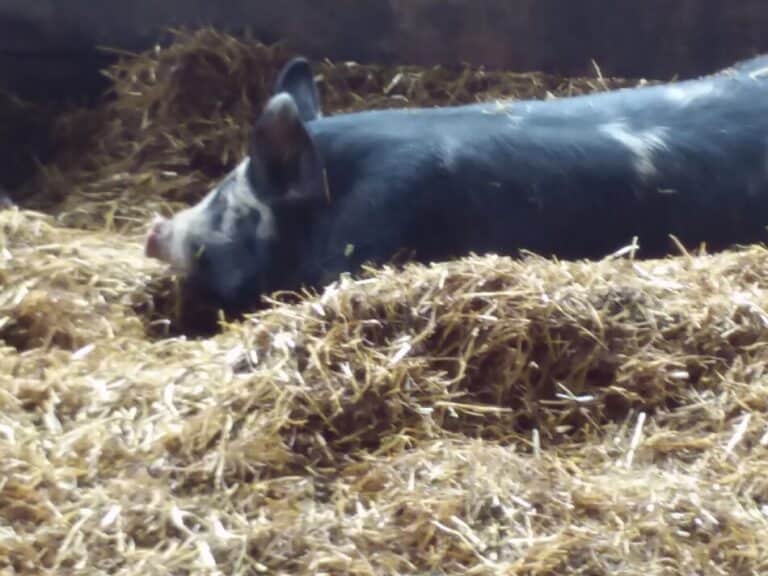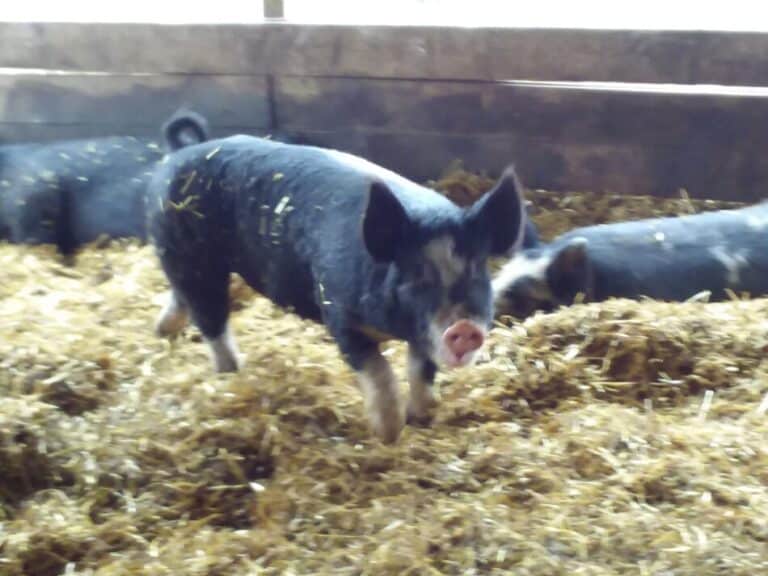Can You Breed Related Pigs?

Breeding closely related pigs together (parent to offspring, siblings or grandparent to offspring) is an option that comes up for many folks with small herds of pigs. Especially if you have an unusual set of genetics that you are working with!
Is breeding closely related pigs a good idea, bad idea or it really doesn’t matter?
You can breed together closely related pigs, however, when you breed closely related pigs you are concentrating the genetics, both the good and the bad, the seen and unseen, in the offspring. If you are not prepared for the consequences of surfacing undesirable genetics due to gene concentration of the closely related parents, do not breed the pigs.
| Breeding boar | Breeding sow (or gilt) | % genetics |
| Boar, average of breed | Sow, average of breed | 50% each parent |
| Father | Daughter | 75% genetics of boar |
| Son | Mother | 75% genetics of sow |
| Littermate | Littermate | 50% |
| Half sibling | Half sibling | 25% |
| Grandsire | Grandpig | 25% |
| Great grandsire | Great grandpig | 12.5% |
| 4th generation unrelated | 4th generation unrelated | 6.2% |
In the table, you’ll see that breeding siblings/littermates together does not concentrate the genetics, whereas breeding a parent to a piglet or grandparent to grandpiglet does concentrate the genetic influence of the older pig.
You can breed closely related pigs
The short answer is “Yes, you can breed related pigs”. The more truthful answer is to add the second half of that statement, which is “as long as you can handle the consequences”.
When you breed closely related pigs you concentrate the genetics, meaning anything that was covered up or “hidden” will surface.
These hidden traits could be good or bad, you don’t know until you do it and live with the results.
It’s important to note here that if you don’t know much about the pigs you are using, then you are concentrating the unknown.
This would be the case for a person new to pigs and pig breeding and isn’t the best idea.
Choosing Pig Breeding Stock gives you tips for picking out your keepers, whether you buy them or pick them from a litter born on your farm.
It’s not really a question of can you breed closely related pigs, it’s more a question of should you.
Linebreeding is purposefully breeding closely related pigs
If you have an established line of pigs and you are looking to “set” some characteristic, then linebreeding (purposefully breeding closely related pigs) is the way to see what genetics you really have in your breeding herd.
In this case you are trying to surface any lurking “bad genes” that have stayed hidden due to genetic diversity of your pigs, the undesirable genes have been diluted to the point that you don’t see their effects.
Reduce the diversity in your pigs by using linebreeding to concentrate the genes and you increase the chance of seeing any hidden genes, if they are in your pigs to begin with.
There is a joke about linebreeding vs. inbreeding basically stating that inbreeding is when it goes wrong and linebreeding is when it goes right. It would be nice if it was that easy but that’s not the case.
Linebreeding can still give bad results, you don’t know until you do it. The reason this is linebreeding is because you are doing this breeding with the purpose of increasing certain genetic influence in the piglets.
As far as the results, you have to wait and see.
If you are a small farm, then keeping extra boars around may not be feasible, so using linebreeding could be your best option.
Genetics is a long term game, you might take a few wrong turns before you start to get to where you want to go with your pigs. But, until you start, you’ll never get any closer to getting the herd you want.
Control Of Inbreeding For Genetic Conservation In Swine by Mark Knauer and Tim Safranski is an article on The Livestock Conservancy site speaking to breeding closely related pigs in breeds with low populations.
Knauer and Safranski note that inbreeding, breeding pigs that are more closely related than the average of the breed, results in smaller litter sizes and slower growth, but can be useful in genetically limited populations.
How Often Can Pigs Breed? goes over the details on breeding and farrowing schedules.
For a knowledgeable pig person, using closely related pigs for breeding can work
It’s only right to mention that the consequences of breeding closely related pigs could be super!
Some of the best breeding stock produced has come from folks using very closely related genetics to a very specific purpose and culling anything that did not make the cut.
For instance, I have a home bred gilt that is bred to Sneaky Pete (link to his bio at Swine Genetics International) and he is the result of some really tight genetics. I’m super excited about these piglets, I love his look!
But, the folks that bred the litter resulting in Sneaky Pete really know their stuff and have years of pig experience, decades actually.
I’m no where near that well versed in pig genetics and, chances are, you aren’t either, meaning you don’t know the potential consequences of the breeding and how to pick pigs with the best chance of giving you what you want in the piglets.
Breeding closely related pigs can have very poor results
More than likely, the rest of us (anyone who hasn’t been breeding pigs for decades) will have more poor results than great results when breeding closely related pigs together.
Tight genetics will concentrate the traits and bring out anything that is hidden by using unrelated breeding stock. This can result in poor growth, bad attitudes, unsound piglets and more.
If you just want piglets, use the boar you’ve got
If all you want is piglets, you can use the boar you have, even if he is already related to the female. But…..if you aren’t willing to chance a bad litter, you need to have a different plan.
If you are just looking to “get the cheapest litter” find another plan, you are headed towards disappointment. Cheaping out on breeding stock will bite you later, always.
However, if you are happy with your boar and feel he is as good as any, give the breeding a shot and see what you get.

Parents bred to offspring are very concentrated genes
Breeding a parent to his or her offspring concentrates the genetics in the piglets, meaning all traits will have extra emphasis. Both the good traits (the ones you want) and the bad traits will be stronger, always.
The reason that breeding parent to offspring is such a big deal is that those piglets now have 75% of their genes from one parent, rather than the 50% that is the norm.
The fear behind this level of genetic concentration is bringing out defects that will have severe consequences to the health of the piglets and/or the health of your wallet!
You should know that breeding closely related pigs does not cause problems, it only allows the problems that have been quietly hiding in the pig’s genetics this entire time to express themselves.
I understand the struggles of being a small pig farmer, I only have two sows and one boar.
One boar is enough to breed 10 sows, so he costs me more per litter than he should, but until some younger stock farrows, this is what I’ve got.
Having more sows would make me much more efficient as far as cost to keep the boar.
With one boar, this means I need to find another boar to keep back any gilts, or I could use A.I. to breed them.
I’m currently keeping back four gilts from my favorite sow. I bought another boar to put in with them rather than chance the risks that come with breeding them to their dad.
I could have just used the boar (their dad), this would have been cheaper, but I would rather deal with another boar than overly concentrate that boar’s genetics in my potential breeding stock.
(Meaning I don’t love him, he’s just okay.)
Boar to daughter breeding will concentrate the genetics of the boar
Using the father of the gilt to breed the gilt will make the resulting piglets 75% genetically the boar and 25% genetically their grandmother (the gilt’s mom).
This means that you will be increasing the influence of the boar’s genetics in those piglets, when compared to their mom (the gilt) and decreasing the grandsow’s influence in the piglets when compared to their mom (the gilt).
Whether this is good or not depends upon what you are trying to do. Do you love the boar’s structure and attitude? Is he everything you desire in a boar?
If so, give this a shot, you might get a nice boar out of the litter or some great looking gilts.
If the boar is not a paragon in your mind, why would you concentrate his influence in the pigs you will be keeping? Concentrating the genetics of a boar I don’t like would be the last thing I would want!
Rather than using the boar that’s just okay and easy because you have him, but he’s not what you want, spend your time and money getting a boar you like then concentrate the great boar’s genetics.
Sow to son breedings concentrate the genetics of the sow
Breeding the sow to her son will concentrate the sow’s genetics in the resulting piglets. The planned piglets will be 75% sow and 25% grandboar, genetically.
Is this sow line the best thing you have ever seen and all you could want in your herd’s genetics? If so, this might be the mating to get more replacement gilts just like their mom.
If not, you are just getting another generation of piglets that will have a higher risk of problems yet a lower level of hardiness and vigor.
Breeding siblings is less concentrated than parent to offspring
Interestingly enough, breeding siblings/littermates is genetically the same concentration as the breeding that produced the littermates.
The littermates are 50% boar and 50% sow, no surprise there! The piglets from the sibling breeding are also 50% grandboar and 50% grandsow.
What this means is that breeding siblings together does not concentrate the genetics the same way as breeding parent to piglet, even though you are using closely related pigs in both cases.
This also means that breeding siblings is not taking your breeding program in any specific direction, since this generation is genetically the same as the one before.
Breeding littermates is a way to see what diversity you have in your genetics, since it kind of recombines or reshuffles the genes in the littermates to see what traits you have to work with.
Breeding half siblings is less concentrated than full siblings
Another not so surprising statement, half siblings are less genetically related than full siblings, but I’m sure you knew that.
What may not have occurred to you is that using a half sibling breeding, while it still would be breeding related pigs, is using less concentrated genetics than using a parent/piglet cross.
For anyone with a small herd, using a half sibling breeding pair is less likely to cause problems than breeding a parent to his or her piglet.
Breeding stock pigs with relatives in common is normal
Using grandparents on grandpiglets or breeding pigs with a grandparent in common is not surprising, especially in breeds with small numbers of breeding stock or when a certain boar line remains popular for multiple years.
I’m not saying you should do this, since these piglets would be 25% (grandparent to grandpiglet) the same genetics, but I am saying that when you have limited choices you do your best.
And, once again, if you are new to pigs, you may not know what the parents of your breeding stock are, meaning you could be using relatives as breeding boars and not realizing that you are doing it.
As long as the results are good, it’s not something to be overly concerned about. If you are not seeing the growth rate and vitality you would expect in your piglets, consider using a different line of genetics to get better results.
Small scale pig keeping: why inbreeding matters by Dr. Michaela Giles notes that the breed average of inbreeding in the U.K. is 5-7%. She also has an extensive chart on percent relatedness of different breeding options.
This is four generations of using non related breeding stock. The 1st breeding of unrelated stock is 50% the same genetics, 2nd breeding 25%, 3rd breeding 12.5% and 4th breeding 6.2%, which is the average stated above.
Resources:
Small scale pig keeping: why inbreeding matters by Dr. Michaela Giles, I used her chart to confirm that my calculations were correct. Note we have differing ways of presenting percent relatedness of parent to piglet breeding, she uses averages, while I use influence of one parent or the other.




